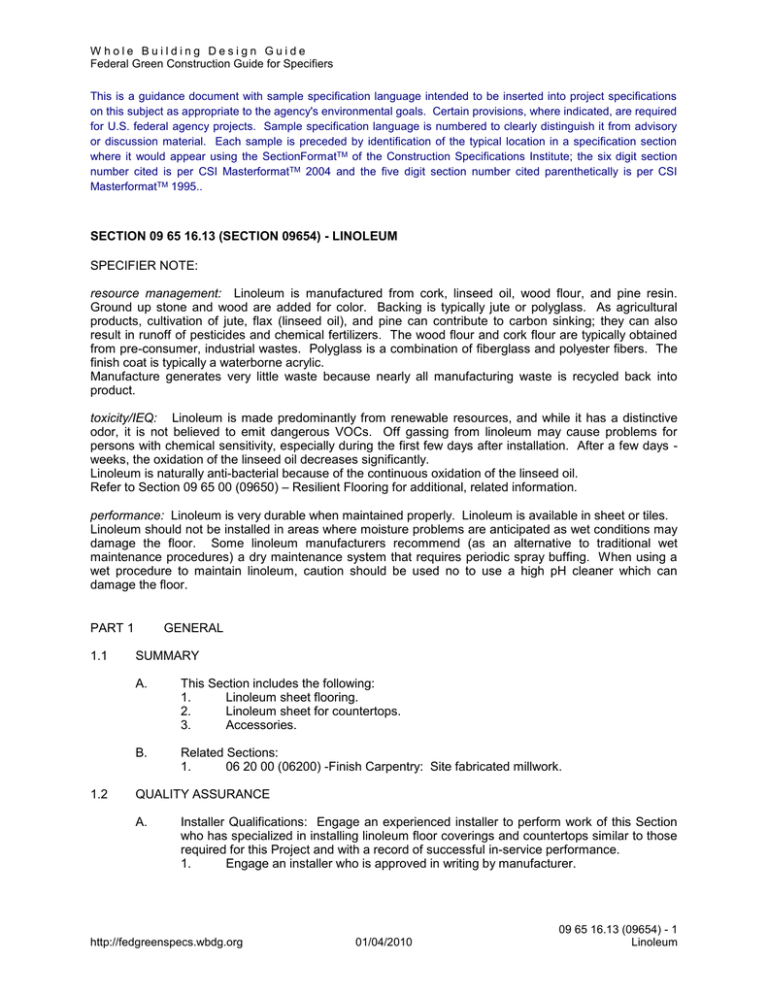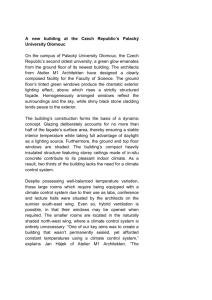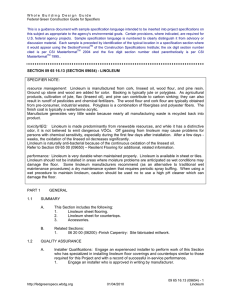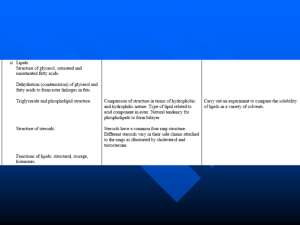Document 12093685
advertisement

Whole Building Design Guide Federal Green Construction Guide for Specifiers This is a guidance document with sample specification language intended to be inserted into project specifications on this subject as appropriate to the agency's environmental goals. Certain provisions, where indicated, are required for U.S. federal agency projects. Sample specification language is numbered to clearly distinguish it from advisory or discussion material. Each sample is preceded by identification of the typical location in a specification section where it would appear using the SectionFormatTM of the Construction Specifications Institute; the six digit section number cited is per CSI MasterformatTM 2004 and the five digit section number cited parenthetically is per CSI MasterformatTM 1995.. SECTION 09 65 16.13 (SECTION 09654) - LINOLEUM SPECIFIER NOTE: resource management: Linoleum is manufactured from cork, linseed oil, wood flour, and pine resin. Ground up stone and wood are added for color. Backing is typically jute or polyglass. As agricultural products, cultivation of jute, flax (linseed oil), and pine can contribute to carbon sinking; they can also result in runoff of pesticides and chemical fertilizers. The wood flour and cork flour are typically obtained from pre-consumer, industrial wastes. Polyglass is a combination of fiberglass and polyester fibers. The finish coat is typically a waterborne acrylic. Manufacture generates very little waste because nearly all manufacturing waste is recycled back into product. toxicity/IEQ: Linoleum is made predominantly from renewable resources, and while it has a distinctive odor, it is not believed to emit dangerous VOCs. Off gassing from linoleum may cause problems for persons with chemical sensitivity, especially during the first few days after installation. After a few days weeks, the oxidation of the linseed oil decreases significantly. Linoleum is naturally anti-bacterial because of the continuous oxidation of the linseed oil. Refer to Section 09 65 00 (09650) – Resilient Flooring for additional, related information. performance: Linoleum is very durable when maintained properly. Linoleum is available in sheet or tiles. Linoleum should not be installed in areas where moisture problems are anticipated as wet conditions may damage the floor. Some linoleum manufacturers recommend (as an alternative to traditional wet maintenance procedures) a dry maintenance system that requires periodic spray buffing. When using a wet procedure to maintain linoleum, caution should be used no to use a high pH cleaner which can damage the floor. PART 1 1.1 1.2 GENERAL SUMMARY A. This Section includes the following: 1. Linoleum sheet flooring. 2. Linoleum sheet for countertops. 3. Accessories. B. Related Sections: 1. 06 20 00 (06200) -Finish Carpentry: Site fabricated millwork. QUALITY ASSURANCE A. Installer Qualifications: Engage an experienced installer to perform work of this Section who has specialized in installing linoleum floor coverings and countertops similar to those required for this Project and with a record of successful in-service performance. 1. Engage an installer who is approved in writing by manufacturer. http://fedgreenspecs.wbdg.org 01/04/2010 09 65 16.13 (09654) - 1 Linoleum Whole Building Design Guide Federal Green Construction Guide for Specifiers B. VOC emissions: Provide low VOC products. [Comply with California Department of Health Services Standard Practice for the Testing of Volatile Organic emissions from Various Sources Using Small-Scale Environmental Chambers, including 2004 Addenda] [and] [or] 1. Adhesives and sealants: Comply with California’s South Coast Air Quality Management District (SCAQMD) #1168 2. Aerosol adhesives: Comply with Green Seal GS-36 3. Hard surface flooring: Comply with FloorScore SPECIFIER NOTE: NSF-ISR has a draft standard for multi-attribute evaluation of environmental preferability: NSF 332 – Sustainability Assessment for Resilient Flooring Coverings The draft standard compares and assesses sustainable product characteristics of resilient flooring. Assessment is implemented through a point system that addresses: materials, water efficiency, energy conservation, air quality, and social issues. Four levels of achievement or compliance are attainable to reflect increasing movement toward sustainability: Conformant, Silver, Gold, and Platinum. http://www.nsf.org/business/sustainability/standards_inprocess.asp?program=Sustainability Edit below to suit project and to reflect latest published standard. C. Provide resilient flooring compliant with NSF 332 [Conformant] [Silver] [Gold] [Platinum] level. 1.3 SUBMITTALS A. Product data. Unless otherwise indicated, submit the following for each type of product provided under work of this Section: SPECIFIER NOTE: Green building rating systems often include credit for materials of recycled content. USGBC-LEED™ v3, for example, includes credit for materials with recycled content, calculated on the basis of pre-consumer and post-consumer percentage content, and it includes credit for use of salvaged/recovered materials. Green Globes US also provides points for reused building materials and components and for building materials with recycled content. 1. Recycled Content: a. Indicate recycled content; indicate percentage of pre-consumer and postconsumer recycled content per unit of product. b. Indicate relative dollar value of recycled content product to total dollar value of product included in project. c. If recycled content product is part of an assembly, indicate the percentage of recycled content product in the assembly by weight. d. If recycled content product is part of an assembly, indicate relative dollar value of recycled content product to total dollar value of assembly. SPECIFIER NOTE: Specifying local materials may help minimize transportation impacts; however it may not have a significant impact on reducing the overall embodied energy of a building material because of efficiencies of scale in some modes of transportation. Green building rating systems frequently include credit for local materials. Transportation impacts include: fossil fuel consumption, air pollution, and labor. USGBC-LEED™ v3 includes credits for materials extracted/harvested and manufactured within a 500 mile radius from the project site. Green Globes US also provides points for materials that are locally manufactured. 2. Local/Regional Materials: a. Sourcing location(s): Indicate location of extraction, harvesting, and recovery; indicate distance between extraction, harvesting, and recovery and the project site. b. Manufacturing location(s): Indicate location of manufacturing facility; indicate distance between manufacturing facility and the project site. http://fedgreenspecs.wbdg.org 01/04/2010 09 65 16.13 (09654) - 2 Linoleum Whole Building Design Guide Federal Green Construction Guide for Specifiers c. d. Product Value: Indicate dollar value of product containing local/regional materials; include materials cost only. Product Component(s) Value: Where product components are sourced or manufactured in separate locations, provide location information for each component. Indicate the percentage by weight of each component per unit of product. SPECIFIER NOTE: Green building rating systems may include credit for low emitting materials. USGBC-LEED™ v3, for example, includes credits for low-emitting materials, including: adhesives and sealants, paints and coatings, carpets, and composite wood and agrifiber products. Under LEED™ v3, adhesives and sealants are to comply with California’s South Coast Air Quality Management District (SCAQMD) #1168; aerosol adhesives are to comply with Green Seal GS-36; interior architectural paints are to comply with Green Seal GS-11; anti-corrosive paints are to comply with Green Seal GS-03 (note – Green Seal has withdrawn GS-03; as of November 2008, anti-corrosive paints are included in a revised GS-11); clear wood finishes are to comply with SCAQMD #1113; carpet with the Carpet and Rug Institute (CRI) Green Label Plus; carpet cushion with CRI Green Label program; and, composite wood and agrifiber products are to contain no added urea-formaldehyde. As per USGBC published Credit Interpretations, the credits for low-emitting materials are directed towards interior, site-installed (i.e. not prefabricated) products. Verify project requirements for low VOC roofing products. Both the Adhesive and Sealant Council (ASC) and the SCAQMD have indicated that low VOC adhesives may have performance difficulties in extreme temperature and humidity conditions. Green Seal, an independent, non-profit organization, certifies low-emitting products using internationally recognized methods and procedures. Green Seal certification meets the criteria of ISO 14020 and 14024, the environmental standards for ecolabeling set by the International Organization for Standardization (ISO); the U.S. Environmental Protection Agency's criteria for third-party certifiers of environmentally preferable products; and the criteria for bona fide ecolabeling bodies of the Global Ecolabeling Network. 3. VOC data: a. Adhesives: 1) Submit manufacturer’s product data for adhesives. Indicate VOC limits of the product. Submit MSDS highlighting VOC limits. 2) Submit Green Seal Certification to GS-36 and description of the basis for certification. 3) [Submit manufacturer’s certification that products comply with SCAQMD #1168.] [Submit manufacturer’s certification that products comply with SCAQMD Rule 1168 in areas where exposure to freeze/thaw conditions and direct exposure to moisture will not occur. In areas where freeze/thaw conditions do exist or direct exposure to moisture can occur, submit manufacturer’s certification that products comply with Bay Area AQMD Reg. 8, Rule 51 for containers larger than 16 oz and with California Air Resources Board (CARB) for containers 16 oz or less.] b. Finish flooring: Submit FloorScore certification. SPECIFIER NOTE: USGBC LEED v3 allows an alternative approach to credit for low emitting flooring materials. It allows credit if all interior flooring elements comply with the California Department of Health Services Standard Practice for the Testing of Volatile Organic emissions from Various Sources Using Small-Scale Environmental Chambers, including 2004 Addenda. [c. Finish Flooring Systems: Submit verification that all interior flooring products, including adhesives and floor finish materials, comply with California Department of Health Services Standard Practice for the Testing of Volatile Organic emissions from Various Sources Using Small-Scale Environmental Chambers, including 2004 Addenda]. http://fedgreenspecs.wbdg.org 01/04/2010 09 65 16.13 (09654) - 3 Linoleum Whole Building Design Guide Federal Green Construction Guide for Specifiers SPECIFIER NOTE: The Food, Conservation, and Energy Act of 2008 (also known as the 2008 U.S. Farm Bill) largely continues programs of the Farm Security and Rural Investment Act of 2002 (2002 Farm Bill) http://www.usda.gov/farmbill/ Section 9002 requires each Federal Agency to develop a procurement program which will assure that items composed of biobased products will be purchased to the maximum extent practicable and which is consistent with applicable provisions of Federal procurement law. USDA designates biobased products for preferred Federal procurement and recommends biobased content levels for each designated product. USGBC-LEED™ v3 includes credits for use of rapidly renewable materials, which USGBC describes as plants harvested within a ten-year cycle. Green Globes – US, provides credit for integration of materials from renewable sources that have been selected based on life-cycle assessment. 4. Biobased materials: a. Indicate type of biobased material in product. b. Indicate the percentage of biobased content per unit of product. c. Indicate relative dollar value of biobased content product to total dollar value of product included in project. B. Submit environmental data in accordance with Table 1 of ASTM E2129 for products provided under work of this Section. PART 2 PRODUCTS SPECIFIER NOTE: EO 13423 includes requirements for Federal Agencies to use “sustainable environmental practices, including acquisition of biobased, environmentally preferable, energy-efficient, water-efficient, and recycled-content products” Specifically, under the Sustainable Building requirements per Guiding Principle #5 Reduce Environmental Impact of Materials, EO13423 directs Federal agencies to “use products meeting or exceeding EPA's recycled content recommendations” for EPA-designated products and for other products to “use materials with recycled content such that the sum of post-consumer recycled content plus one-half of the preconsumer content constitutes at least 10% (based on cost) of the total value of the materials in the project.” Additionally, for USDA-designated biobased products, Federal agencies must use products meeting or exceeding USDA's biobased content recommendations; and for other products, biobased products made from rapidly renewable resources and certified sustainable wood products. And, under the Sustainable Building requirements per Guiding Principle #4 Enhance Indoor Environmental Quality, EO13423 directs Federal agencies to use “materials and products with low pollutant emissions, including adhesives, sealants, paints, carpet systems, and furnishings.” Executive Order 13514; Federal Leadership in Environmental, Energy, and Economic Performance; was signed on October 5, 2009. http://www.ofee.gov/execorders.asp It expands upon the environmental performance requirements of EO 13423. http://www1.eere.energy.gov/femp/regulations/printable_versions/eo13423.html EO 13514 sets numerous federal requirements in several areas, including sustainable buildings and communities. Federal agencies must implement high performance sustainable federal building design, construction, operation and management, maintenance, and deconstruction, including: Ensuring all new Federal buildings, entering the design phase in 2020 or later, are designed to achieve zero net energy by 2030. Ensuring all new construction, major renovations, or repair or alteration of Federal buildings comply with the Guiding Principles of Federal Leadership in High Performance and Sustainable Buildings http://www1.eere.energy.gov/femp/pdfs/mouhighperfsustainfedfacs.pdf http://fedgreenspecs.wbdg.org 01/04/2010 09 65 16.13 (09654) - 4 Linoleum Whole Building Design Guide Federal Green Construction Guide for Specifiers Ensuring at least 15% of existing agency buildings and leases (above 5,000 gross square feet) meet the Guiding Principles by fiscal year 2015 and that the agency makes annual progress towards 100% compliance across its building inventory. 2.1 LINOLEUM SHEET FLOORING A. Style and Color: [As selected by Architect from manufacturer's full range] Patterns and colors shall extend through entire floor covering thickness. B. Sheet Floor Covering: ASTM F 2034. SPECIFIER NOTE: NFPA 101, "Life Safety Code," requires that floor covering materials in exits and in accesses to exits meet critical radiant flux limitations in certain occupancies. Authorities having jurisdiction may impose other restrictions. Edit below to suit Project. 1. Critical Radiant Flux Classification: Class I, not less than 0.45 W/sq. cm per ASTM E 648. 2. Seaming Method: [Standard] [Heat welded]. SPECIFIER NOTE: 0.08-inch- (2.0-mm-) thick linoleum is typically used for residential traffic applications only. Consult manufacturers for recommendations on thickness appropriate to project applications. 3. Thickness: [0.08 inch (2.0 mm)] [0.10 inch (2.5 mm)] [0.13 inch (3.2 mm)] [0.16 inch (4.0 mm)] [0.18 inch (4.5 mm)]. SPECIFIER NOTE: For current designations under the Federal Biobased Products Preferred Procurement Program (FB4P), refer to www.biobased.oce.usda.gov. As of January 4, 2010, the Federal Register includes designations for approximately 60 product types. The requirements for purchasing biobased items apply to those items directly purchased by the federal agency. Under a construction contract, the contractor's use of hydraulic fluid in its bulldozers and backhoes is incidental to the purpose of its contract, so the contractor is not required to use biobased hydraulic fluids. The Office of the Federal Environmental Executive (OFEE) recommends that agencies encourage the use of these items, however. Currently designated items that affect construction include: Roof Coatings Water Tank Coatings Adhesive and Mastic Removers Composite Panels Fertilizers Plastic Insulating Foam Carpet and Upholstery Cleaners Carpets Dust Suppressants Packaging Films Glass Cleaners Hydraulic Fluids – Stationary Equipment Wood and Concrete Sealers Cleaners The USDA currently has identified about 150 items for which it is collecting test data needed for the additional designations of items that will extend preferred procurement status to include all qualifying biobased products. 4. Biobased Material: Consisting of oxidized linseed or other vegetable drying oil and rosin, mixed with ground cork or wood flour, mineral filler, and natural pigments. Mixture shall be bonded and keyed to a burlap (jute) or other suitable fibrous backing so that backing is partially embedded in mixture. a. Product shall be completely biodegradable. http://fedgreenspecs.wbdg.org 01/04/2010 09 65 16.13 (09654) - 5 Linoleum Whole Building Design Guide Federal Green Construction Guide for Specifiers b. 2.2 ACCESSORIES A. Trowelable Leveling and Patching Compounds: Latex-modified, portland cement based or blended hydraulic cement based formulation as approved by floor covering manufacturer for applications indicated. B. Adhesives: 1. Toxicity/IEQ: Comply with applicable regulations regarding toxic and hazardous materials, GS-36 for Commercial Adhesive, [South Coast Air Quality Management District Rule 1168] [Bay Area AQMD Reg. 8, Rule 51 for containers larger than 16 oz and with California Air Resources Board (CARB) for containers 16 oz or less], and as specified. C. Heat-Welding Bead: Solid-strand product of floor covering manufacturer. 1. Color: [As selected by Architect from manufacturer's full range to contrast with floor covering] [Match floor covering] [xxxxx]. D. Integral-Flash-Cove-Base Accessories: 1. Cove Strip: 1-inch (25.4-mm) radius provided or approved by floor covering manufacturer. 2. Cove-Base Cap Strip: [Square metal] [rubber cap] provided or approved by floor covering manufacturer. E. Edge Strips: 1. Extruded aluminum with mill finish, of width shown, of height required to protect exposed edge of floor covering, and in maximum available lengths to minimize running joints. 2. 1 inch wide rubber taper strips; color similar to linoleum color. PART 3 3.1 Biobased Content: Minimum [xxxx] percent. EXECUTION PREPARATION A. Prepare substrate for product installation in accordance with manufacturer's published instructions. B. Remove ridges, bumps, and other irregularities. Fill cracks, contraction joints, holes, and depressions with subfloor filler as recommended by manufacturer to achieve smooth, flat, hard surface. C. Apply subfloor filler and leveler to provide finished concrete surface smooth, with no more than 1/8 inch variation from plane within 10 feet in any direction. D. Mechanically remove adhesive, paint, oils, waxes, sealers and curing compounds on substrate not compatible with adhesive to be used. Do not use solvents. E. Moisture Test: Determine suitability of concrete substrate for receiving resilient flooring with regard to moisture content and curing compounds. Use bond test recommended by flooring manufacturer. Ensure that moisture content in concrete substrate does not exceed 3 percent as measured by the Calcium Carbide Hygrometer Procedure or 5 percent by normal Protimeter. F. Prohibit traffic until filler is cured. G. Vacuum clean substrate. http://fedgreenspecs.wbdg.org 01/04/2010 09 65 16.13 (09654) - 6 Linoleum Whole Building Design Guide Federal Green Construction Guide for Specifiers 3.2 3.3 3.X SHEET FLOORING INSTALLATION A. Install resilient tile flooring in accordance with manufacturer's published instructions. B. Maintain uniformity of floor covering direction. C. Arrange for a minimum number of seams and place them in inconspicuous and low-traffic areas, and not less than 6 inches (150 mm) away from parallel joints in flooring substrates. D. Match edges of sheet flooring for color shading and pattern at seams according to manufacturer's written recommendations. E. Avoid cross and butt seams. F. Eliminate deformations that result from hanging method used during the drying process (stove bar marks) according to manufacturer's written recommendations. G. Integral Flash Cove Base: Where indicated, cut sheet flooring to form integral base of height indicated at vertical surfaces. Form integral flash cove base by flashing sheet flooring up vertical surfaces. Support floor covering at horizontal and vertical junction with cove strip. Butt floor covering at top of base against cap strip. H. Terminate flooring at centerline of door openings where adjacent floor finish is dissimilar. Where flooring continues through door opening, continue established pattern with no interruption. I. Unless otherwise indicated, install edge strips at unprotected or exposed edges and where flooring transitions to carpet or other floor finish. SHEET LINOLEUM INSTALLATION (COUNTERTOPS) A. Install in accordance with manufacturer's published instructions. B. Seams will not be permitted, except as approved in advance by Architect. C. Coordinate installation of linoleum countertops with millwork installation. SITE ENVIRONMENTAL PROCEDURES A. Indoor Air Quality: 1. Temporary ventilation: Provide temporary ventilation as specified in Section 01 57 19.11 (01352) – Indoor Air Quality (IAQ) Management, and as follows:. a. Ventilate products prior to installation. Remove from packaging and ventilate in a secure, dry, well-ventilated space free from strong contaminant sources and residues. Provide a temperature range of 60 degrees F minimum to 90 degree F maximum continuously for minimum 72 hours. Do not ventilate within limits of Work unless otherwise approved by Architect. B. Waste Management: As specified in Section 01 74 19 (01351) – Construction Waste Management and as follows: 1. Scrap linoleum with jute backing may be shredded and composted on site. END OF SECTION http://fedgreenspecs.wbdg.org 01/04/2010 09 65 16.13 (09654) - 7 Linoleum







